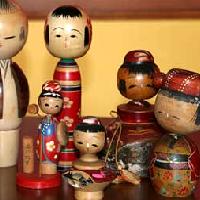Japanese Kokeshi Doll ATC's
Launch gallery slideshow

| Swap Coordinator: | AmigurumiNymph (contact) |
| Swap categories: | Artist Trading Card (ATC) |
| Number of people in swap: | 3 |
| Location: | Other |
| Type: | None |
| Last day to signup/drop: | October 30, 2008 |
| Date items must be sent by: | November 15, 2008 |
| Number of swap partners: | 2 |
| Description: | |
|
I LOVE these little Japanese Dolls!! They're adorable, and with just a little bit of paint so expressive! Let's make some Kokeshi Doll ATC's!! !!!You will make 2xCards for 2xPartners for a total of 4xATC's !!! *4.9+ *Newbies welcome with a complete profile! *Let me know if you have any questions! I know you don't need this much info but here's a little bit from Wikipedia about Kokeshi Dolls: Kokeshi (å°èŠ¥å, kokeshi?), are Japanese dolls, originally from northern Japan. They are handmade from wood, have a simple trunk and an enlarged head with a few thin, painted lines to define the face. The body has a floral design painted in red, black, and sometimes yellow, and covered with a layer of wax. One characteristic of Kokeshi dolls is their lack of arms or legs. The bottom is marked with the signature of the artist. Kokeshi was first produced by Kiji-shi (wood artisans) in Shinchi, in Togatta/Miyagi Prefecture from where Kokeshi making techniques spread to other spa areas in the TÅhoku Region. It is said that these dolls were originally made from the middle of the Edo period (1600-1868) to be sold to people who were visiting the hot springs in the north-east of the country. Traditional Kokeshi (Dento) dolls shapes and patterns became particular to a certain area and are classified under eleven types including: Tsuchiyu, Togatta, Yajiro, Naruko, Sakunami, Yamagata, Kijiyama, Nanbu, Tsugaru, Zao-takayu, and Hijioro. The most dominant type is the Naruko variety originally made in Miyagi Prefecture, which can also be found in Akita, Iwate, and Yamagata prefectures. The main street of the Naruko Hot Spring resort is known as Kokeshi Street and has shops which are operated directly by the Kokeshi carvers. Creative Kokeshi (Shingata) allow the artist complete freedom in terms of shape, design and color and were developed after World War II (1945). They are not particular to a specific region of Japan and generally creative Kokeshi artists are found in the cities. The woods used for Kokeshi vary with cherry used for its darkness and dogwood which is softer. Itaya-kaede, a Japanese maple is also used. In the creation of both traditional and creative dolls. The wood is left outdoors to season for one to five years before it can be used. | |
Discussion
Leave a Comment
You must be logged in to leave a comment. Click here to log in.
- Info:
- Home
- |
- About
- |
- Forum Rules
- |
- Terms of Use
- |
- Press
- |
- Advertising
- |
- Blog
- |
- Graphics & Stuff
- Help:
- New User Info
- |
- FAQ
- |
- Group Info
- |
- Glossary
- |
- Forums
- |
- |
- Contact Admin

